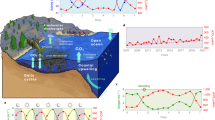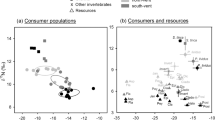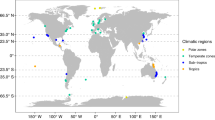Abstract
Ocean ecosystems are predicted to lose biodiversity and productivity from increasing ocean acidification1. Although laboratory experiments reveal negative effects of acidification on the behaviour and performance of species2,3, more comprehensive predictions have been hampered by a lack of in situ studies that incorporate the complexity of interactions between species and their environment. We studied CO2 vents from both Northern and Southern hemispheres, using such natural laboratories4 to investigate the effect of ocean acidification on plant–animal associations embedded within all their natural complexity. Although we substantiate simple direct effects of reduced predator-avoidance behaviour by fishes, as observed in laboratory experiments, we here show that this negative effect is naturally dampened when fish reside in shelter-rich habitats. Importantly, elevated CO2 drove strong increases in the abundance of some fish species through major habitat shifts, associated increases in resources such as habitat and prey availability, and reduced predator abundances. The indirect effects of acidification via resource and predator alterations may have far-reaching consequences for population abundances, and its study provides a framework for a more comprehensive understanding of increasing CO2 emissions as a driver of ecological change.
This is a preview of subscription content, access via your institution
Access options
Subscribe to this journal
Receive 12 print issues and online access
$209.00 per year
only $17.42 per issue
Buy this article
- Purchase on Springer Link
- Instant access to full article PDF
Prices may be subject to local taxes which are calculated during checkout



Similar content being viewed by others
References
Jackson, J. B. C. Ecological extinction and evolution in the brave new ocean. Proc. Natl Acad. Sci. USA 105, 11458–11465 (2008).
Kroeker, K. J., Kordas, R. L., Crim, R. N. & Singh, G. G. Meta-analysis reveals negative yet variable effects of ocean acidification on marine organisms. Ecol. Lett. 13, 1419–1434 (2010).
Briffa, M., de la Haye, K. & Munday, P. L. High CO2 and marine animal behaviour: Potential mechanisms and ecological consequences. Mar. Pollut. Bull. 64, 1519–1528 (2012).
Fabricius, K. E., De’ath, G., Noonan, S. & Uthicke, S. Ecological effects of ocean acidification and habitat complexity on reef-associated macroinvertebrate communities. Proc. R. Soc. B 281, 20132479 (2014).
Werner, E. E. & Peacor, S. D. A review of trait-mediated indirect interactions in ecological communities. Ecology 84, 1083–1100 (2003).
Preisser, E. L., Bolnick, D. I. & Benard, M. F. Scared to death? The effects of intimidation and consumption in predator–prey interactions. Ecology 86, 501–509 (2005).
Tylianakis, J. M., Didham, R. K., Bascompte, J. & Wardle, D. A. Global change and species interactions in terrestrial ecosystems. Ecol. Lett. 11, 1351–1363 (2008).
Pörtner, H. O. & Farrell, A. P. Physiology and climate change. Science 322, 690–692 (2008).
Tuomainen, U. & Candolin, U. Behavioural responses to human-induced environmental change. Biol. Rev. 86, 640–657 (2011).
Wootton, J. T. The nature and consequences of indirect effects in ecological communities. Ann. Rev. Ecol. Syst. 25, 443–466 (1994).
Connell, S. D., Kroeker, K. J., Fabricius, K. E., Kline, D. I. & Russell, B. D. The other ocean acidification problem: CO2 as a resource use among competitors for ecosystem dominance. Phil. Trans. R. Soc. B 368, 20120442 (2013).
Lönnstedt, O. M., McCormick, M. I., Chivers, D. P. & Ferrari, M. C. O. Habitat degradation is threatening reef replenishment by making fish fearless. J. Anim. Ecol. 83, 1178–1185 (2014).
Gilman, S. E., Urban, M. C., Tewksbury, J., Gilchrist, G. W. & Holt, R. D. A framework for community interactions under climate change. Trends Ecol. Evol. 25, 325–331 (2010).
Chapman, S. et al. Publishing trends on climate change vulnerability in the conservation literature reveal a predominant focus on direct impacts and long time-scales. Divers. Distrib. 20, 1221–1228 (2014).
Poloczanska, E. S. et al. Global imprint of climate change on marine life. Nature Clim. Change 3, 919–925 (2013).
Wootton, J. T., Pfister, C. A. & Forester, J. D. Dynamic patterns and ecological impacts of declining ocean pH in a high-resolution multi-year dataset. Proc. Natl Acad. Sci. USA 105, 18848–18853 (2008).
Wittmann, A. C. & Pörtner, H. O. Sensitivities of extant animal taxa to ocean acidification. Nature Clim. Change 3, 995–1001 (2013).
Ådahl, E., Lundberg, P. & Jonzén, N. From climate change to population change: The need to consider annual life cycles. Glob. Change Biol. 12, 1627–1633 (2006).
Ockendon, N. et al. Mechanisms underpinning climatic impacts on natural populations: Altered species interactions are more important than direct effects. Glob. Change Biol. 20, 2221–2229 (2014).
Mumby, P. J. & van Woesik, R. Consequences of ecological, evolutionary and biogeochemical uncertainty for coral reef responses to climatic stress. Curr. Biol. 24, R413-R423 (2014).
Munday, P. L., McCormick, M. I. & Nilsson, G. E. Impact of global warming and rising CO2 levels on coral reef fishes: What hope for the future? J. Exp. Biol. 215, 3865–3873 (2012).
Ferrari, M. C. O. et al. Effects of ocean acidification on visual risk assessment in coral reef fishes. Funct. Ecol. 26, 553–558 (2012).
Munday, P. L., Cheal, A. J., Dixson, D. L., Rummer, J. L. & Fabricius, K. E. Behavioural impairment in reef fishes caused by ocean acidification at CO2 seeps. Nature Clim. Change 4, 487–492 (2014).
Hale, M. E. Locomotor mechanics during early life history: Effects of size and ontogeny on fast-start performance of salmonid fishes. J. Exp. Biol. 202, 1465–1479 (1999).
Husak, J. F. Does speed help you survive? A test with collared lizards of different ages. Funct. Ecol. 20, 174–179 (2006).
Werner, E. E. & Anholt, B. R. Ecological consequences of the tradeoff between growth and mortality-rates mediated by foraging activity. Am. Nat. 142, 242–272 (1993).
Folke, C. et al. Regime shifts, resilience, and biodiversity in ecosystem management. Ann. Rev. Ecol. Evol. Syst. 55, 557–581 (2004).
Kelly, M. W. & Hofmann, G. E. Responses to global climate change–adaptation and the physiology of ocean acidification. Funct. Ecol. 27, 980–990 (2013).
Allan, B. J. M., Miller, G. M., McCormick, M. I., Domenici, P. & Munday, P. L. Parental effects improve escape performance of juvenile reef fish in a high-CO2 world. Proc. R. Soc. B 281, 20132179 (2014).
Walsh, M. R. The evolutionary consequences of indirect effects. Trends Ecol. Evol. 28, 23–29 (2013).
Meinshausen, M. et al. The RCP greenhouse gas concentrations and their extensions from 1765 to 2300. Climatic Change 109, 213–241 (2011).
Boatta, F. et al. Geochemical survey of Levante Bay, Vulcano Island (Italy), a natural laboratory for the study of ocean acidification. Mar. Pollut. Bull. 73, 485–494 (2013).
Brinkman, T. J. & Smith, A. M. Effect of climate change on crustose coralline algae at a temperate vent site, White Island, New Zealand. Mar. Freshwat. Res. 66, 360–370 (2015).
Shaw, E. C., Munday, P. L. & McNeil, B. I. The role of CO2 variability and exposure time for biological impacts of ocean acidification. Geophys. Res. Lett. 40, 4685–4688 (2013).
Mehrbach, C., Culberon, C. H., Hawley, J. E. & Pytkowicz, R. M. Measurements of the apparent dissociation constants of carbonic acid in seawater at atmospheric pressure. Limnol. Oceanogr. 18, 897–907 (1973).
Dickson, A. G. & Millero, F. J. A comparison of the equilibrium-constants for the dissociation of carbonic-acid in seawater media. Deep Sea Res. A 34, 1733–1743 (1987).
Dickson, A. G., Sabine, C. L. & Christian, J. R. (eds.) Guide to best practices for ocean CO2 measurements. PICES Spec. Pub. 3, 1–191 (2007)
Syms, C. & Jones, G. P. Scale of disturbance and the structure of a temperate fish guild. Ecology 80, 921–940 (1999).
Guidetti, P., Terlizzi, A., Fraschetti, S. & Boero, F. Changes in Mediterranean rocky-reef fish assemblages exposed to sewage pollution. Mar. Ecol. Prog. Ser. 253, 269–278 (2003).
Feary, D. A. & Clements, K. D. Habitat use by triplefin species (Tripterygiidae) on rocky reefs in New Zealand. J. Fish Biol. 69, 1031–1046 (2006).
Winer, B. J., Brown, D. R. & Michels, K. M. Statistical Principles in Experimental Design 3rd edn, 1057 (McGraw-Hill, 1991).
Acknowledgements
We thank T. Rossi for help in the field and design of Supplementary Fig. 2 and G. Grammer for assisting with fish otolith dissections. Financial support was provided by the Environment Institute (The University of Adelaide) and ARC future fellowships to I.N. (grant no. FT120100183), S.D.C. (grant no. FT0991953) and B.M.G. (grant no. FT100100767), and an ARC Discovery grant to B.D.R. and S.D.C. (DP150104263).
Author information
Authors and Affiliations
Contributions
I.N. and S.D.C. conceived and designed the experiments. I.N. and S.D.C. performed the experiments. I.N., B.D.R. and S.D.C. analysed the data. B.D.R. and B.M.G. contributed materials/analysis tools. All authors contributed to writing the manuscript.
Corresponding author
Ethics declarations
Competing interests
The authors declare no competing financial interests.
Supplementary information
Rights and permissions
About this article
Cite this article
Nagelkerken, I., Russell, B., Gillanders, B. et al. Ocean acidification alters fish populations indirectly through habitat modification. Nature Clim Change 6, 89–93 (2016). https://doi.org/10.1038/nclimate2757
Received:
Accepted:
Published:
Issue Date:
DOI: https://doi.org/10.1038/nclimate2757
This article is cited by
-
Projected ocean acidification and seasonal temperature alter the behaviour and growth of a range extending tropical fish
Coral Reefs (2023)
-
Potential ecosystem regime shift resulting from elevated CO2 and inhibition of macroalgal recruitment by turf algae
Theoretical Ecology (2023)
-
Monitoring marine fishes using underwater video techniques in the Mediterranean Sea
Reviews in Fish Biology and Fisheries (2023)
-
Battery-free wireless imaging of underwater environments
Nature Communications (2022)
-
Climate change and species facilitation affect the recruitment of macroalgal marine forests
Scientific Reports (2022)



